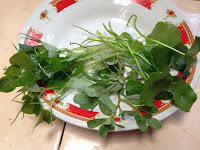
I am into eating or drinking food without thinking of it as a supplement or medicine but merely as part of a natural diet. For me, pre-emptive measures are always better than trying to treat a condition. This is where the Bentong Ginger and Turmeric drink has become a regular on my diet. I find the taste to my liking and it has been easy to maintain drinking it, more so by the benefits that I am reaping.
The drink comprises of Bentong ginger and turmeric, organically grown of course. I sometimes drink it unsweetened or add organic brown sugar or honey or
gala nipah. I tend to make concentrates that I can store in the fridge and have it ready to drink at any time. In the evenings, I like to have it warm. Sometimes I have it as a cool drink, especially on hot afternoons. It has a refreshing taste. When I travel, I like to bring a bottle ready-to-drink, just in case I get motion sickness. If I know that I will be travelling through winding roads, I like to drink it before I start the journey.

The Bentong ginger is different from the regular ginger in that it has a stronger taste. It can be grown is the ground as well as in containers.With the right soil composition and fertilisation, can be harvested in 8 months. In research, gingerol is found to be the main pharmacological agent. Ginger's main properties include:
- anti-inflammatory
- antioxidant
- antiemetic
Amongst the benefits are:
- improves digestion
- reduces inflammation
- improves circulation
- strengthens the immunity system
- improves muscle and joint health
- reduces pain from osteoarthritis
- improved carbohydrate and lipid metabolism
- reduce nausea
- Lowers cholesterol (LDL)
Due to its nausea reducing properties, it is also taken by people who undergo chemotherapy to reduce the nauseous side effect of the treatment.

Turmeric is easy to grow in our climate and can be grown in the ground and in containers. With the right still composition and fertilisation, it can be harvested in 6 months. In research, curcumin is thought to be the main pharmacological agent. Turmeric's main properties include:
- anti-inflammatory
- antiseptic
- antioxidant
Amongst the benefits are:
- improves healing of wounds
- improves brain function and lowers risks of brain diseases
- improves rheumatoid arthritis ( In Ayurvedic treatments, turmeric is one of the elements used)
- improves digestive problems (In Germany, the German Commission E which approves what herbs can be used safely has approved the use of turmeric for digestive problems.)
I lead a physical life, doing lots of manual work on the farm. At times, I get carried away and only realise the effect once I stop. I will feel the sore muscles as well as joint pains. In the last 2 months, this is no longer an issue. I find that I am more flexible and my muscle recover faster. I use to not be able to rise from a full squat position without holding on to something and now, I can do it without aid.
I also find that my digestion has improved which also leads to easy bowel movements. I also tend to eat less and do not get any bloated feeling after any meal and I eat all kinds of things. My skin condition has also improved. I prepare the drink by cooking it in a claypot and I avoid using any metal pots to prevent any reaction with the metal. I place the crushed turmeric and ginger (which I pound using a mortar and pestle) with water and bring it to a boil before allowing it to simmer for at least a couple of hours. When it is cool, I will strain it and place in bottles and store in the fridge. I find that it can last at least one month in the fridge. I do not add any sweeteners to it as this will allow me to use it in many ways for consumption. Using only organically grown Bentong ginger and turmeric, I can be assured that I am not introducing chemical toxins which would otherwise defeat the purpose for a healthy drink.
This combination also have been purported to have preventive and therapeutic benefits for diabetes. From a holistic therapy view, it has many benefits and many preventive benefits. Since I enjoy the drink, I find that it is not a chore to include it in my diet. Apart from using the concentrate as I drink, I also have it on hand to add to my cooking of any protein (fish, beef and chicken) as well as to spice up my olive oil salad dressing. Through my reading, I find that it has no known negative side effects when taken in moderation.
I look forward to seeing if I will also get all the other benefits from this drink and since there is no known side effect, I am using myself as my test subject. To date, I have already reap some benefits :)









